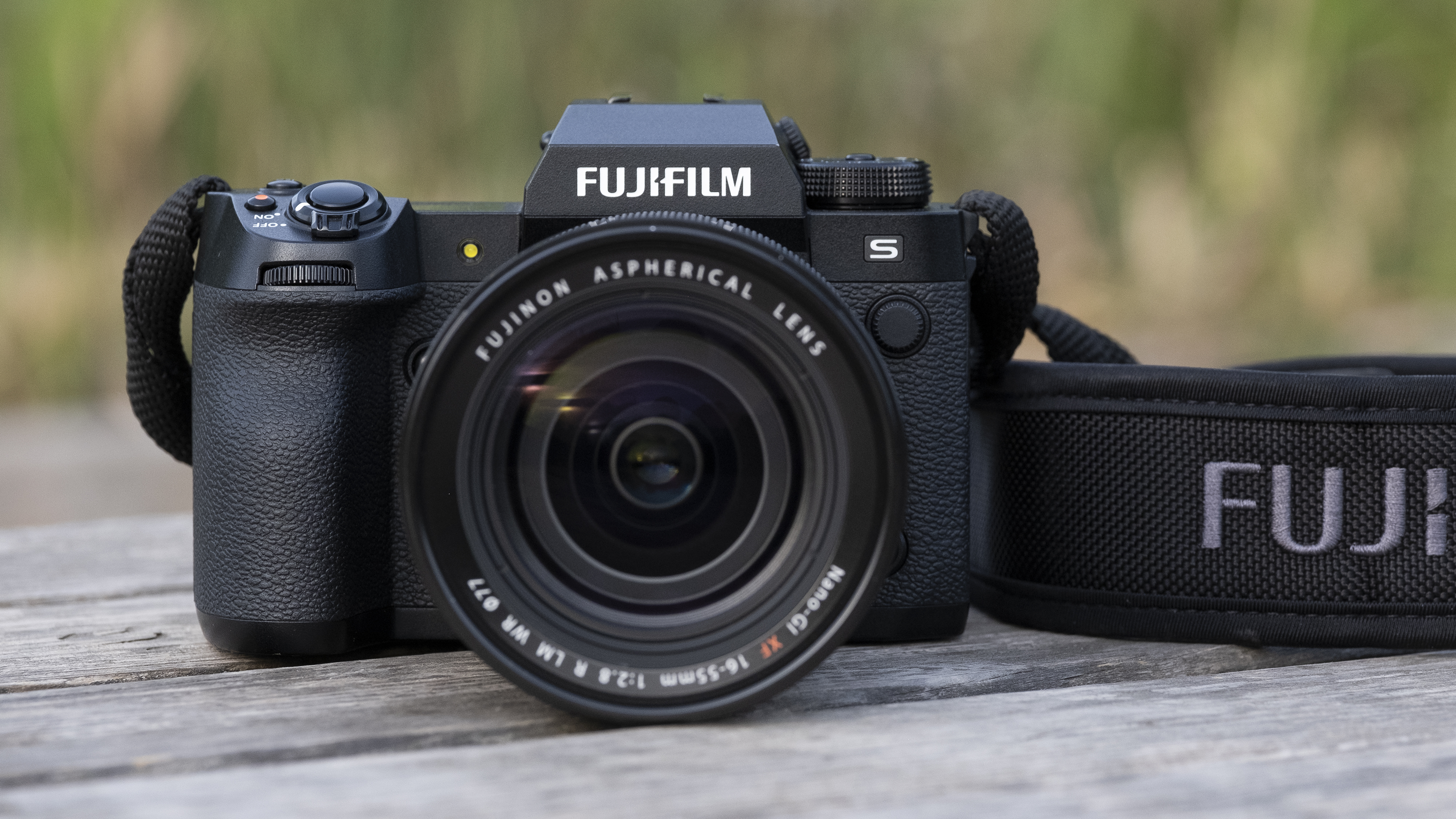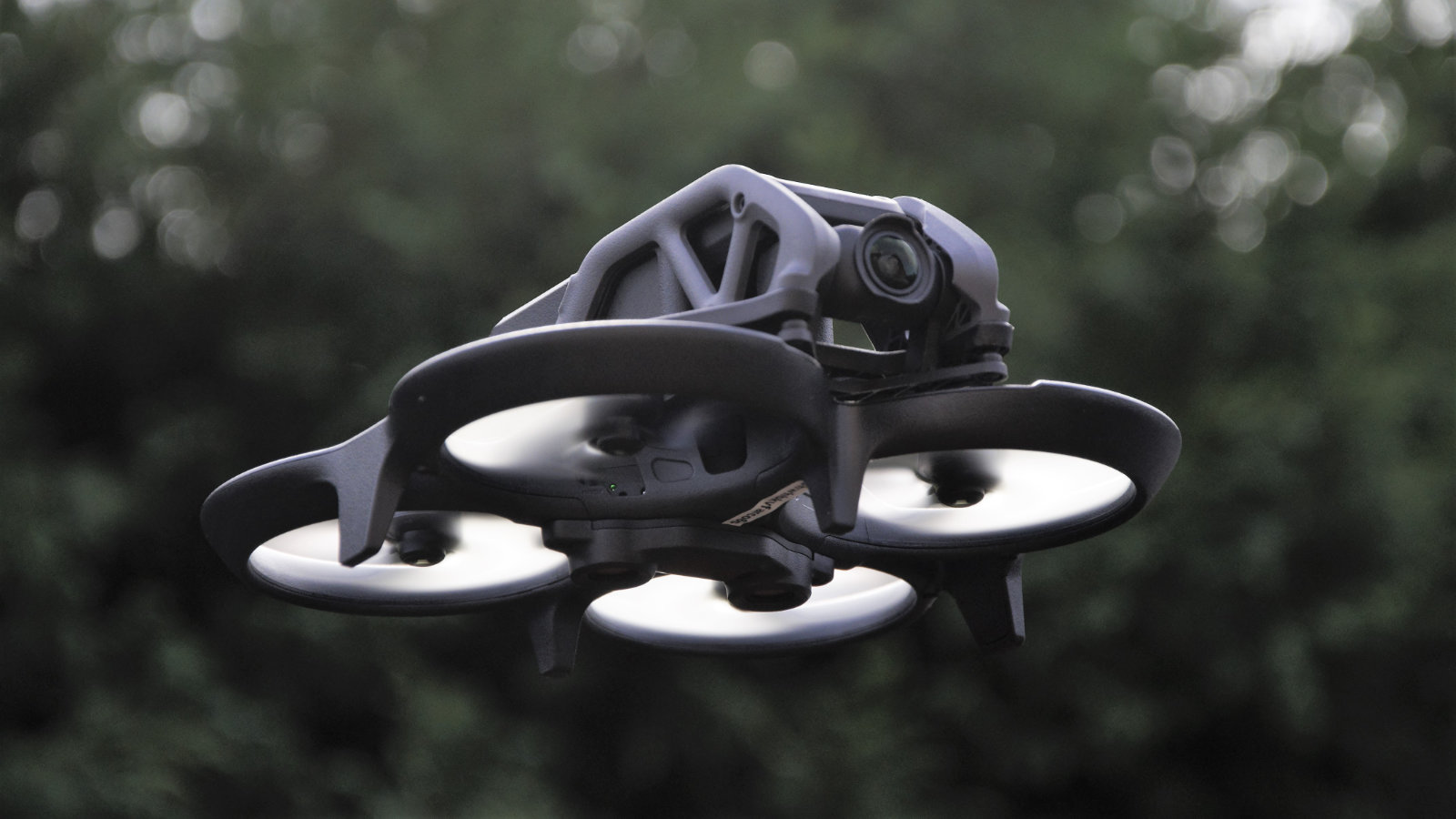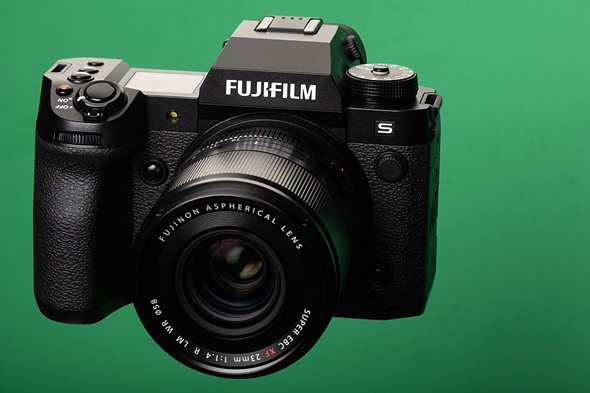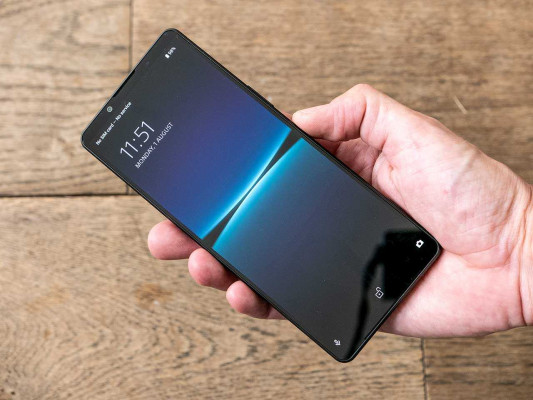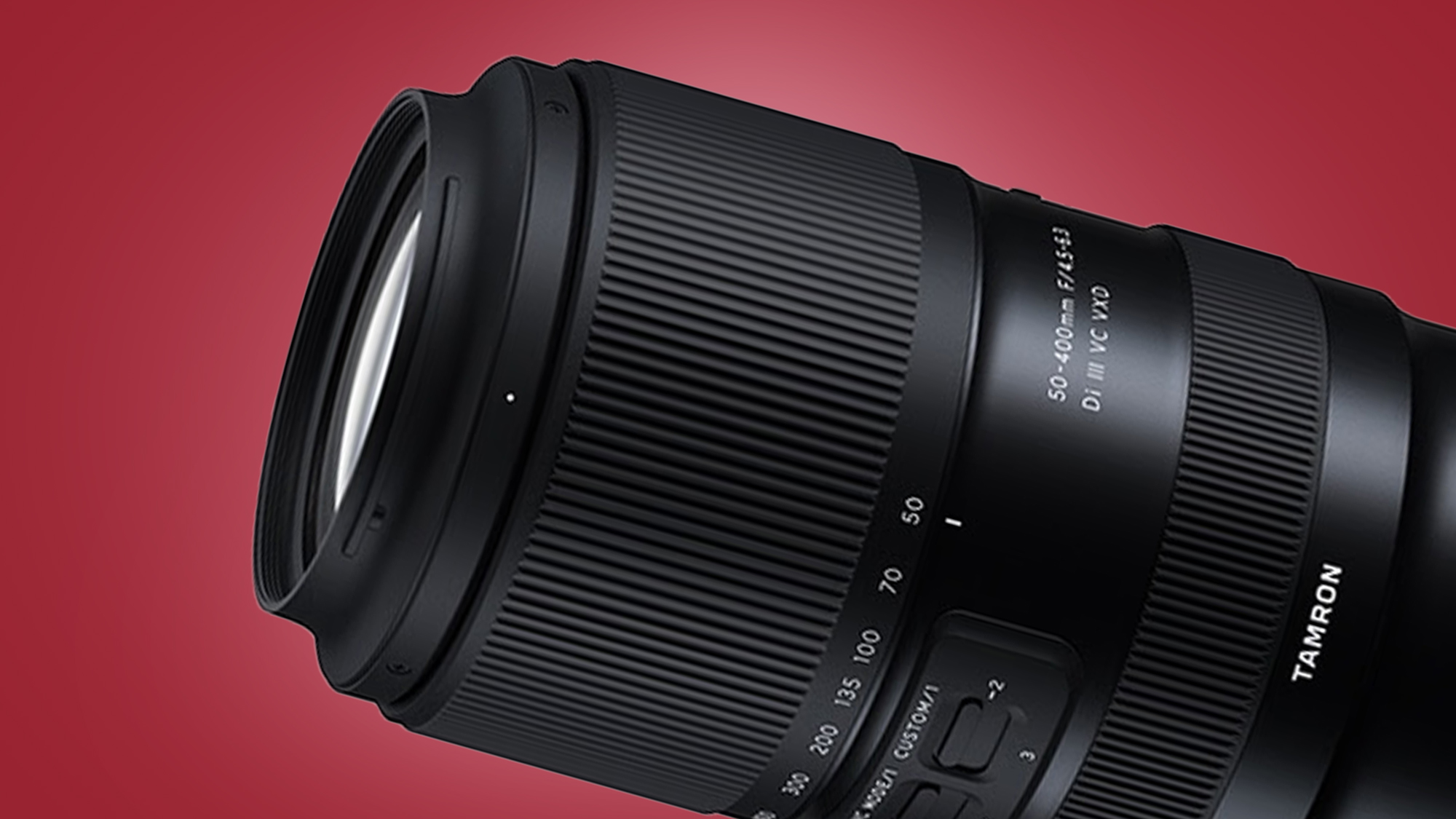Reviews

Fujifilm X-H2 first impressions review
DPReview Latest |
The Fujifilm X-H2 is a high-end 40MP APS-C mirrorless camera for both stills and video shooting. Its high-resolution stills and 8K video capabilities stand in contrast to the high-speed shooting and fast readout 4K capabilities of its X-H2S sister model.
Key specifications
- 40MP BSI CMOS X-Trans APS-C sensor
- 15 fps with mechanical shutter (20 with e-shutter and 1.29x crop)
- 8K, 6.2K, or 2:1 oversampled 4K video at up to 30p
- Three versions of Pro Res, H.265 or H.264 video encoding
- Built-in image stabilization rated to 7.0 stops
- 5.76M-dot EVF capable of up to 120 fps refresh
- 1 CFexpress Type B, 1 UHS-II SD card slot
- Full-sized HDMI port
- 680 shot-per-charge battery rating (CIPA)
- Compatibility with battery grip or transmitter module
The X-H2 will be available from late September at a recommended cost of $1,999.
The X-H2 is compatible with both the VG-XH battery grip, which takes two batteries and costs $399, and the file transfer grip launched alongside it at a cost of $999. It's also compatible with the $199 add-on fan unit, if you want to record longer periods of high-res video.
Jump to:
What's new | How it compares | Body & handling | Initial impressions | Sample gallery | Specifications
What's new
40MP BSI X-Trans CMOS sensor
 |
The biggest new feature of the X-H2 is its use of a new 40MP BSI CMOS sensor, the highest-resolution chip of its size we've seen in a consumer camera. A BSI sensor doesn't offer the significant speed benefits of the Stacked CMOS chip in the X-H2S, but is likely to deliver slightly lower read noise while also allowing the camera to be less expensive.
It's an APS-C chip with an X-Trans color filter array up front. This filter is designed to reduce the risk of moiré appearing compared to Bayer filters (where it's still a risk even with high-res sensors and bright, sharp lenses) by having a less regularly-repeating pattern to its red and blue channels; however there's a narrower choice of software that'll get the very best out of it.
We'll be looking more closely at the new sensor once we're able to get a production version into our testing studio, but we'd expect its additional detail to come with some increase in noise when viewed at 100% (simply because each individual pixel will get less light). What's going to be more interesting is looking at its whole-image quality, to see whether there's any overall noise cost to its higher level of detail capture.
8K video
 |
| Mic, headphones and a full-sized HDMI socket: video is just as central to the X-H2 as it is to the X-H2S. |
The move to a 40MP sensor gives the X-H2 enough pixels to deliver 8K video from the full width of its sensor, and sure enough that's what the camera offers, at framerates of up to 30p. There's also a 2:1 oversampled 'HQ' 4K mode taken from this 8K capture, or a sub-sampled version that can be shot at up to 60p.
If 8K is more than you're looking for, the camera offers a 6.2K mode that also appears to be oversampled and derived from the 8K output. Interestingly, the 6.2K footage is in the 16:9 aspect ratio commonly used in video, unlike the similarly-named mode in the X-H2S that produces the taller 3:2, photo-shaped output. We have to assume that the change is to provide a degree of flexibility for cropping or post-shot detail processing without the file sizes of shooting in 8K.
The X-H2 offers the same extensive choice of codecs for video capture, with a choice of H.264 of H.265 compression with either 4:2:0 or 4:2:2 subsampling and Long-GOP or All-I encoding. In addition, you can capture ProRes 422 HQ, 422, or 422LT files, meaning there should be an option to fit your chosen workflow.
The camera can output a UHD 8K (7680 x 4320) Raw video stream that can be encoded as ProRes RAW if you have an Atomos Ninja V+ recorder, or BRaw if you have a Blackmagic Video Assist.
Of course the move to a slower sensor means the X-H2 can't match the impressive readout rates of the X-H2S, and there's been significant rolling shutter visible in the footage we've shot so far. The X-H2 includes an F-Log2 option, but it's likely to offer slightly less usable dynamic range than the X-H2S with its 14-bit readout.
Pixel shift high-resolution mode
Fujifilm already has a pixel-shift high resolution mode in its GFX medium format cameras, but this is its first appearance in a camera with an X-Trans color filter pattern. The less-frequent repeat pattern means that the camera has to take 20 images to get a single pixel sensor movement between each one, but the end result is a set of files that can be combined into a 160MP image using the downloadable 'Pixel Shift Combiner' software.
Autofocus
The X-H2 offers the same range of subject recognition autofocus modes as the X-H2S. AF speed may take a hit because the X-H2 can't read out its sensor as fast as the 'S' model, though AF information usually comes from a faster, low-resolution readout, so this may not be a factor.
 |
| Face/Eye | Animal | Car | Motorbike & bIke | Airplane | Birds | Trains |
|---|---|---|---|---|---|---|
|
|
|
|
|
|
|
As with the X-H2S, the subject recognition modes are entirely distinct from the camera's face and eye tracking modes, so you'll need to assign two custom buttons if you want quick access to both. The camera does not return to the previously used mode if you turn face/eye or subject detection on then off.
Assigning a button to engage subject tracking doesn't give you a way to switch between subject modes; to do that you'll need to use the Q or main menu. We found the subject recognition modes to generally work well on the X-H2S, and the X-H2 uses the same processor and algorithms, so we'd expect similar performance in terms of identifying the chosen target. Whether the camera can maintain the same overall AF performance with its slower readout is something we'll test.
CFexpress Type B / UHS-II SD
 |
The X-H2 uses the same combination of CFexpress Type B and UHS-II compatible SD card slots as its sibling. As on X-H2S, the CFe slot really comes into its own when shooting video, especially in the data-heavy ProRes formats. The faster format also provides the bandwidth to clear bursts of those 40MP images from the buffer quickly, but a lot of stills shooters will probably get by fine with a fast SD card.
Shutter mechanism
Just in case the X-H2's high-end status isn't obvious, Fujifilm stresses that its shutter mechanism, as well as being able to shoot at 1/8000 sec and continuously at up to 15 fps, is also rated to offer a lifespan of 500,000 shots. These are details we're only used to seeing on high-end pro-focused cameras.
How it compares
The high-end APS-C camera is something of a rare beast these days, and indeed to match its resolution would send you to the higher-end full-frame cameras, where you face a rather different balance of image quality, size, and cost. There's currently nothing that tries to shoot 8K footage this side of the Canon EOS R5, whose original list price was nearly twice as high.
Body and handling
 |
The body of the X-H2 is identical to that of the X-H2S, with the exception of the model name and 'S' badge on the front of the high-speed model. As befits a body that's likely to make sense for landscape work, it's one of the best-sealed bodies Fujifilm has yet made.
This means it has the same command-dial-led user interface as the X-H2S, GFX 100S, and 50S II, that gives you a fast at-your-fingertips way of working (one that will be familiar to the users of just about every brand). By default the front dial controls the primary exposure setting and the rear controls exposure comp (with the exception of M mode, where you can configure a button to get Exp Comp when using Auto ISO). You can't assign other functions to the dials, though, even if you're using a lens's aperture ring in preference to a command dial.
 |
| The X-H2 uses the same 1.62M-dot fully-articulated touchscreen LCD as the X-H2S, and can also be used with the optional screw-in fan unit (via the five connection points exposed, lower right). |
The viewfinder and screens are the same as the X-H2S, with a fully-articulating rear 1.62M-dot touchscreen and large 0.8x mag, 5.76M-dot OLED finder. It's a huge viewfinder, to the point where it can sometimes be difficult to see the whole display when wearing glasses, despite the relatively generous 24mm eyepoint.
The body has a substantial front grip and ten customizable buttons (with the option of also using the four directions of the four-way controller, plus four swipe directions on the rear screen). The use of single-function command dials, rather than the clickable ones on many previous X-Series cameras, gives a more solid, dependable feel to their operation, and removes the risk of inadvertently clicking into a different mode at a crucial moment. The downside is you can't assign settings such as ISO to the dials.
 |
The menus are a continuation of those used in recent Fujifilm models and are generally well organized and easy to navigate. There's a lot going on within them, and it's certainly worth exploring them when you first pick up the camera, to decide which of the many features you wish to assign to a custom button (there are 73 assignable options in total).
As with other recent Fujifilm cameras, you can also customize which functions appear in the camera's Q menu. The Q menu can be modified to contain between four and sixteen options, with separate menus for stills and video mode and the choice of whether the 'buttons' appear on a grey or transparent background.
 |
You can also create up to seven custom settings banks that can then be accessed from the camera's mode dial. These settings banks capture just about all the camera's settings when set, with no option to exclude parameters that you might not want to change, so think carefully as you define them.
The level of customization extends to letting you decide what information is shown on the LCD and in the EVF, what appears in the easier-to-read 'Large Indicator' mode, and whether that appears in the LCD, EVF, or neither. You can also customize what information the camera's top panel display shows, with separate settings for stills and video.
Battery
 |
The X-H2 uses the same NP-W235 battery as the X-H2S, X-T4, and some GFX models. It offers a fairly substantial 16Wh capacity and powers the camera to a CIPA battery rating of 680 shots per charge using the rear LCD. This is a very impressive number and suggests the camera is less power-hungry than the X-H2S. A rating this high means that only the most demanding of shoots (such as a wedding) are likely to challenge the capacity of the battery, since it's common to achieve more than twice the rated number of shots (depending on how you shoot).
The optional VG-XH vertical grip adds capacity for two extra batteries, increasing the battery life 2.4 times to 1,600 shots. If all else fails you can also power the camera directly from a suitably powerful USB-C PD source.
Initial impressions
 |
With the arrival of the X-H2 we can finally clearly see that the 'H' really does mean hybrid. It's not a case of the X-H2S being 'the video model' and the X-H2 being 'the stills model,' but more a case of the X-H2S being the high-speed option and the X-H2 being the high resolution one, as both appear similarly adept at stills and video.
The BSI sensor can't deliver the impressively low rolling shutter rates that the H2S can, but even with significant rolling shutter, the X-H2 is by far the least-expensive ILC to shoot 8K at present. Usefully, it will deliver many of the benefits of that high resolution in its 6.2K and 4K footage if you don't plan to output at a resolution that most people can't currently play back.
 |
In our brief time with the camera we found a few little inconveniences (such as the selection of subject recognition modes, and not giving the option of using one of the dials for ISO), but these are things we can hope to be amended with firmware. In the meantime, though, the X-H2 delivers the same fast-to-use, decently customizable interface in a very comfortable, ergonomic body.
Of course, those X-H1 users hoping for an exact repeat of that camera's control system are likely to be disappointed: the X-H2 uses the same GFX-derived command-dial interface as the X-H2S. Its hybrid credentials also means it gets the same fully-articulating rear display as the S, which may come as a letdown for those hoping for the more stills-orientated tilt screen used on some previous X-T cameras (and the original X-H1, for that matter).
If Fujifilm seems to be embracing the more modern, conventional operating style, rather than the throwback one seen elsewhere in the X-series, well, there's a reason it's become the default way most high-end cameras work. And I find it hard to believe that Fujifilm plans to completely abandon the dedicated-dial fan club it's spent a decade cultivating, just because its hybrid line has done so.
 |
We've enjoyed our time with the X-H2 so far. It's a relatively big body for an APS-C camera, but it's difficult to make a weathersealed camera with lots of control points, that feels solid, fits well in the hand, and includes a usefully robust battery much smaller. Witticisms about it being 'nearly the size of a full-frame camera' ring hollow when you mount any of the F2 lenses on it. To us it makes sense, given what it's trying to deliver.
What will be interesting to see is whether it gets usurped by its stable-mates, once they get upgraded to the latest generation of processors and sensors. But now that there's a clear 'hybrid' series of cameras in Fuji's lineup, it may free future X-T models from the need to do a bit of everything. Where the X-T4 appeared to fill the gap between generations of X-H models, a potential X-T5 perhaps has room to be its own camera.
Sample gallery
All images shot using a pre-production Fujifilm X-H2.
Please do not reproduce any of these images on a website or any newsletter/magazine without prior permission (see our copyright page). We make the originals available for private users to download to their own machines for personal examination or printing (in conjunction with this review); we do so in good faith, so please don't abuse it.








